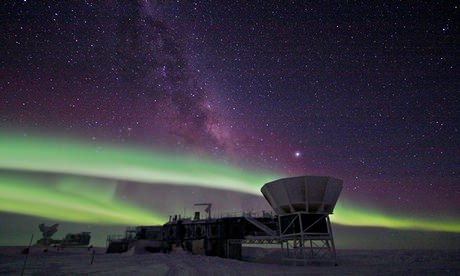A new galactic dust map, compiled using data gathered from the European Space Agency’s Planck Mission, has cast further doubt over what was once hailed as one of the biggest scientific claims of the century, according to media reports.In March, researchers working with a specialized telescope at the South Pole, known as BICEP2, reported extremely faint pinwheel-like swirls in the afterglow of the big bang—the so-called cosmic microwave background (CMB). They claimed they had found traces of gravitational waves rippling through the infant universe—direct evidence that the newborn cosmos had undergone a bizarre exponential growth spurt known as inflation. But the supposed signal might have been emitted by warm dust within our own galaxy, others argued. Now, data from the European Space Agency’s Planck spacecraft show that dust accounts for some, and possibly all, of the BICEP signal.
“We’ve gone from ‘They can’t prove that it isn’t dust’ to ‘It’s probably dust,’ ” says David Spergel, a cosmologist at Princeton University who is not a member of the BICEP team. But George Efstathiou, a cosmologist at the University of Cambridge in the United Kingdom and a member of the Planck team, cautions that the new data do not prove that the BICEP signal was entirely spurious.
In fact, to keep people from jumping to that conclusion, the Planck team decided not to issue a press release when it posted its paper to the arXiv preprint server and submitted it to Astronomy & Astrophysics, Efstathiou says. “It’s very tricky stuff,” he says, “so we were anxious that it not go into the press as ‘Planck says that BICEP is wrong’ because it doesn’t.”
The new data do show that the BICEP team underestimated the “galactic foreground” radiation. BICEP2—short for Background Imaging of Cosmic Extragalactic Polarization 2—took data from 2010 to 2012, aiming to map the polarization of the primordial microwaves in a small patch of sky. To maximize the instrument’s sensitivity, researchers designed it to detect microwaves of only one frequency, 150 gigahertz (GHz).
But the push to improve sensitivity came at a cost. To distinguish radiation from dust and other galactic foregrounds from the CMB, cosmologists generally take data at multiple frequencies. So BICEP researchers had to rely on other groups’ estimates of the dust foreground in their field of view—including preliminary numbers presented in a talk by Planck researchers.
Now researchers with Planck, which took data from 2009 to 2013, have mapped dust emissions across the entire sky and have shown that dust could account for some or all of the BICEP signal. The map shows dust emissions at a frequency of 353 GHz; to estimate emissions at BICEP’s frequency of 150 GHz, Planck researchers extrapolated using the average spectrum for dust emissions. But that extrapolation is “solid,” Spergel says.
The presence of dust “can only diminish” the BICEP signal, acknowledges Clement Pryke, a cosmologist at the University of Minnesota, Twin Cities, and a co–principal investigator for the BICEP team. “I’m not going to say ‘Goddamn it, there’s a cosmological signal there,’ ” Prkye says. “I’m not going to say there isn’t, either.” The BICEP and Planck teams are working on a joint analysis that should provide a more definitive answer, perhaps by year’s end, he says.
Some researchers say the BICEP team made its result seem much stronger than it was by announcing it in a press conference and a press release that proclaimed the “first direct evidence of cosmic inflation.” “It’s a very bold gamble that’s been taken,” Princeton cosmologist William Jones said at the time. But BICEP researchers felt pressure from the media to stake a definite claim, Pryke says: “They’re trying to translate this into something that the public can understand, and they want a yes or no.”
Charles Bennett, a cosmologist at Johns Hopkins University in Baltimore, Maryland, says his impression is that BICEP researchers thought they’d nailed the discovery. “They just got overenthusiastic,” he says, “but it’s tough to know when you really have something.” BICEP researchers might have done better to simply post their preprint as the Planck team has done, Bennett says. “If the result held up, they would have gotten credit anyway,” he says.
The new Planck results have sobering implications, Bennett says. They suggest the sky is relatively dusty and that extracting evidence of primordial gravitational waves may take years and multiple experiments, he says. Max Tegmark, a cosmologist at the Massachusetts Institute of Technology in Cambridge, is more optimistic. “There are places in the sky that seem to be twice as clean” as BICEP’s field of view, he says. “So people are going to look there.”
Agencies/Canadajournal

 Canada Journal – News of the World Articles and videos to bring you the biggest Canadian news stories from across the country every day
Canada Journal – News of the World Articles and videos to bring you the biggest Canadian news stories from across the country every day


Its truely amazing to see everything in the sky. Hopefully soon they will be able to understand how a person can really see/view the sky’s working beauty with their eyes…. ::)